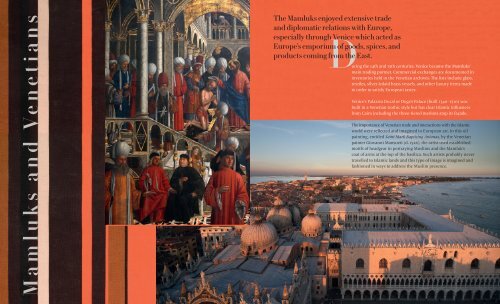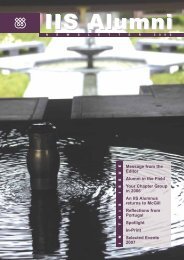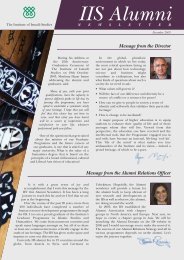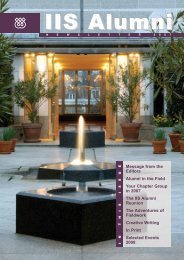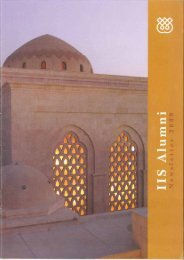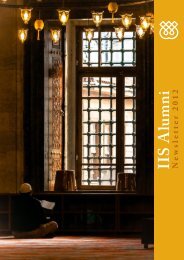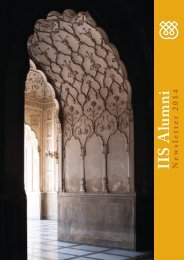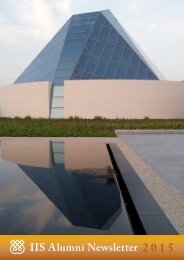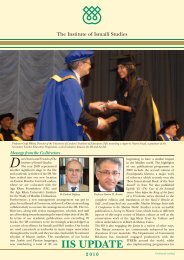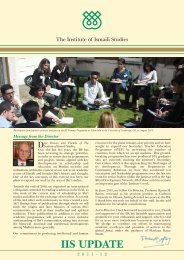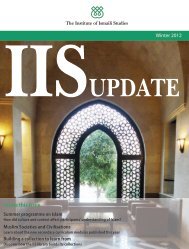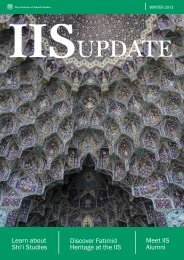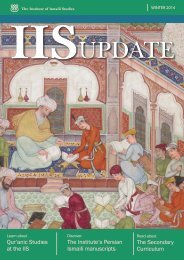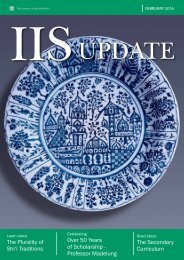IJ Mamluks and Venetians
Extract from Islam an Illustrated Journey - Mamluks and Venetians
Extract from Islam an Illustrated Journey - Mamluks and Venetians
You also want an ePaper? Increase the reach of your titles
YUMPU automatically turns print PDFs into web optimized ePapers that Google loves.
<strong>Mamluks</strong> <strong>and</strong> <strong>Venetians</strong><br />
The <strong>Mamluks</strong> enjoyed extensive trade<br />
<strong>and</strong> diplomatic relations with Europe,<br />
especially through Venice which acted as<br />
D<br />
Europe’s emporium of goods, spices, <strong>and</strong><br />
products coming from the East.<br />
uring the 14th <strong>and</strong> 15th centuries, Venice became the <strong>Mamluks</strong>’<br />
main trading partner. Commercial exchanges are documented in<br />
inventories held in the Venetian archives. The lists include glass,<br />
textiles, silver-inlaid brass vessels, <strong>and</strong> other luxury items made<br />
to order to satisfy European tastes.<br />
Venice’s Palazzio Ducal or Doge’s Palace (built 1340–1510) was<br />
built in a Venetian Gothic style but has clear Islamic influences<br />
from Cairo including the three-tiered merlons atop its façade.<br />
The importance of Venetian trade <strong>and</strong> interactions with the Islamic<br />
world were reflected <strong>and</strong> imagined in European art. In this oil<br />
painting, entitled Saint Mark Baptising Anianas, by the Venetian<br />
painter Giovanni Mansueti (d. 1526), the artist used established<br />
motifs of headgear in portraying Muslims <strong>and</strong> the Mamluk’s<br />
coat of arms at the top of the basilica. Such artists probably never<br />
travelled to Islamic l<strong>and</strong>s <strong>and</strong> this type of image is imagined <strong>and</strong><br />
fashioned in ways to address the Muslim presence.
The Mongols encouraged trade <strong>and</strong> exchange between<br />
the regions they conquered which contributed to<br />
a cultural synthesis between the eastern <strong>and</strong> western<br />
parts of their empire–a legacy that continued into<br />
later centuries.<br />
The section of a tapestry shown opposite displays a<br />
blending of Chinese, Central Asian, Persian <strong>and</strong> Arab<br />
influences. It was probably part of a tent panel or<br />
wall-hanging <strong>and</strong> was made in Iraq or Western Iran<br />
early in the 14th century using a Chinese technique<br />
known as kesi (cut silk) in which gold thread is spun<br />
around cotton. The textile depicts a prince in Mongol<br />
garb, seated on a throne with a turbanned Arab or<br />
Persian official <strong>and</strong> another wearing a Mongol-style hat.<br />
Other figures hold up a large parasol. There are images<br />
of warriors <strong>and</strong> animals, as well as arabesques <strong>and</strong><br />
floral motifs. An Arabic inscription containing phrases<br />
of good wishes including ‘perpetual glory’, ‘prosperity’,<br />
‘wealth’ <strong>and</strong> ‘well-being’ encircles the entire medallion.<br />
The detail of a watercolour painting on silk shown<br />
left was made in Iran or Central Asia around 1425–1450<br />
during the Timurid period. The painting depicts a<br />
gathering of nobles enjoying music <strong>and</strong> food in a garden.<br />
The party is watched over by a brilliantly coloured bird<br />
in a flowering tree, a motif that is likely derived from<br />
Chinese silk paintings.<br />
After murdering the last Abbasid caliph in Baghdad,<br />
al-Mustaʿsim (d. 1258), <strong>and</strong> completing his conquest of<br />
Iraq, Hülegü then set his sights on the l<strong>and</strong>s of the Eastern<br />
Mediterranean. While the Mongols managed to invade <strong>and</strong><br />
occupy parts of Anatolia <strong>and</strong> Syria, they were defeated at<br />
ʿAyn Jalut, in Palestine in 1260 by the skilled slave-soldiers<br />
of the <strong>Mamluks</strong>. Thereafter, Hülegü <strong>and</strong> his Il-Khanid heirs<br />
became the rulers of Iraq <strong>and</strong> Iran, eventually normalising<br />
relations with both the <strong>Mamluks</strong> <strong>and</strong> other rivals.<br />
New Synthesis<br />
Scholars remain divided about the long-term impact of the<br />
Mongol invasions on Muslim societies in Asia. In the short<br />
term, the raids cut off trade, shut down manufacturing,<br />
displaced populations <strong>and</strong> fractured cultural activity. But<br />
in many cities <strong>and</strong> towns that had offered the Mongols their<br />
allegiance, however nominal, life continued as usual. The<br />
Mongols gave the local rulers of these allied places such as<br />
Shiraz <strong>and</strong> Yazd the status of local governor. Eventually, <strong>and</strong><br />
after almost half a century of conquest, the Mongols began<br />
to settle <strong>and</strong> societies in the Mongol realms began to recover<br />
from the devastation <strong>and</strong> gradually return to prosperity.<br />
After the conquests, the Mongols fostered a cultural<br />
synthesis between their traditional worldview <strong>and</strong> lifestyle<br />
<strong>and</strong> the beliefs <strong>and</strong> practices of the conquered peoples. In<br />
China, for example, the Great Khans patronised Confucianism<br />
<strong>and</strong> Buddhism by building temples, supporting their<br />
institutions of learning <strong>and</strong> recruiting their sages into the<br />
Mongol administration. Similarly, the early Il-Khans of Iran<br />
were tolerant of different religious communities including<br />
Buddhists, Nestorian Christians, Jews <strong>and</strong> Muslims.<br />
The establishment of Mongol rule throughout Asia<br />
facilitated interregional trade. This was particularly the case<br />
between China <strong>and</strong> Iran where the Il-Khans were able to<br />
facilitate the movement of people, goods <strong>and</strong> ideas between<br />
their realms <strong>and</strong> those of their kinsmen in China. Evidence<br />
of these exchanges <strong>and</strong> their legacy is found in the art from<br />
the period. The Mongols, who were particularly fond of<br />
textiles, metalwork, ceramics <strong>and</strong> other well-crafted luxury<br />
goods, elevated the status of traders <strong>and</strong> facilitated the<br />
mobility of craftsman, both of which resulted in the movement<br />
of diverse techniques, styles, patterns <strong>and</strong> motifs<br />
around the Mongol realms. Under the Mongols, culture<br />
became portable.<br />
229
The ink drawing on paper shown below was made in Mongol Iran<br />
in the 14th century. It shows a tent mosque with two men, each<br />
reading from a Qurʾan resting on a st<strong>and</strong>. The tent is topped with<br />
two st<strong>and</strong>ards that read ‘Allah’ <strong>and</strong> an inscription on the tent<br />
drapery reads ‘All sovereignty belongs to Allah (al-mulk li’llah)’.<br />
Il-Khans<br />
The Il-Khanid dynasty located their capital at Maragha <strong>and</strong><br />
Tabriz, in northwestern Iran. They built palaces <strong>and</strong> maintained<br />
tented encampments (sing. ordu) to accommodate<br />
their traditional practice of moving their court between<br />
winter <strong>and</strong> summer pastures. One of the most impressive<br />
<strong>and</strong> finely decorated Mongol summer palaces was Takht-i<br />
Sulayman (built ca. 1275), on the site of a former Sasanian<br />
fire temple. To administer their l<strong>and</strong>s, the Il-Khans also<br />
took on advisors from different religious traditions.<br />
Among the most famous of these advisors was the Shiʿi<br />
polymath Nasir al-Din al-Tusi (d. 1274). Al-Tusi was born in<br />
Tus, Khurasan, into a Twelver (Arabic, Ithnaʿashari) Shiʿi<br />
family in 1201. He studied philosophy at Nishapur <strong>and</strong> was<br />
drawn to the ideas of Ibn Sina (Latin, Avicenna, d. 1037).<br />
He was also attracted by Ismaili thought <strong>and</strong> made his way<br />
to the Ismaili castles of Quhistan, as a result of the Mongol<br />
invasions, where he enjoyed the patronage of the Nizari<br />
Ismaili ruler <strong>and</strong> wrote a number of important treatises in<br />
Arabic <strong>and</strong> Persian, including works on ethics such as the<br />
Akhlaq-i Nasiri (Nasirean Ethics). When Hülegü laid siege<br />
to the Ismaili castles of Daylam in 1256, al-Tusi was with<br />
the Nizari Ismaili Imam Khurshah (d. 1257) <strong>and</strong> attempted<br />
to negotiate his surrender. After the fall of the Ismaili<br />
headquarters at Alamut, however, Imam Khurshah, then in<br />
Mongolia, was killed <strong>and</strong> his successors went into hiding,<br />
concealing their identity under the guise of Sufism. Yet,<br />
al-Tusi survived <strong>and</strong> Hülegü took him on as an advisor <strong>and</strong><br />
built an observatory <strong>and</strong> library for him at Maragha. From<br />
here, al-Tusi continued his work in the religious sciences,<br />
particularly on Twelver theology, as well as mathematics,<br />
metaphysics <strong>and</strong> astronomy. He died in 1274 <strong>and</strong> was buried<br />
in Baghdad next to the grave of the seventh Twelver Imam,<br />
Musa al-Kazim.<br />
In 1295, Hülegü’s gr<strong>and</strong>son Ghazan (d. 1304) converted<br />
to Islam under the tutelage of Saʿd al-Din Hammuya (or<br />
Hammuʾi, a shaykh of the Kubrawiyya Sufi order (founded<br />
in Khwarazm by Najm al-Din Kubra [d. 1221] in the 13th<br />
century). Ghazan’s conversion led to the Il-Khans’ patronage<br />
of mosques, madrasas, mausolea <strong>and</strong> other institutions.<br />
Ghazan’s chief advisor, Rashid al-Din (d. 1318), himself a<br />
Spared the Il-Khanid invasions <strong>and</strong> later ruled by the Timurids,<br />
Yazd was amongst the most culturally vibrant cities in central<br />
Iran from the 13th century onward. During the rule of the<br />
Timurid appointed governor Jalal al-Din Chaqmaq (d. unknown)<br />
in the 15th century, Yazd became an important religious centre.<br />
Chaqmaq <strong>and</strong> his wife established a large complex that included<br />
a mosque, khanqah, confectioner’s shop, cistern <strong>and</strong> qanat (water<br />
channel) alongside a bathhouse <strong>and</strong> caravanserai. The complex’s<br />
portal (shown opposite) is decorated with glazed tiles alternating<br />
with plain bricks to create geometric patterns, a technique<br />
known as banaʾi or hazar baf. Over the centuries, a number of<br />
these structures were continually renovated <strong>and</strong> repurposed.<br />
Today, the complex also houses a tekke, a place where Shiʿi<br />
Muslims gather to commemorate the martyrdom of al-Husayn,<br />
the Prophet’s gr<strong>and</strong>son.<br />
convert to Islam from Judaism, was a patron of the arts<br />
<strong>and</strong> set up a book atelier (kitabkhana) in one of the quarters<br />
of Ghazaniyya, a suburb of Ghazan’s capital city outside<br />
Tabriz. It was at this atelier that some masterpieces of<br />
illustrated manu-scripts were produced including a copy<br />
of Rashid al-Din’s own Jamiʿ al-tawarikh (Compendium<br />
of Chronicles), a survey of world dynasties <strong>and</strong> a history<br />
of the Mongols, the great Mongol Shahnama, <strong>and</strong> a lesser<br />
known translated, illustrated work on Chinese medicine,<br />
Tansuqnama, which indicates the complex relationship<br />
between the knowledge traditions of Islamic Iran <strong>and</strong> China.<br />
Rashid al-Din also served under Ghazan’s successor,<br />
Öljeitü (d. 1316), who made his capital at Sultaniyya, near<br />
Maragha, in northwestern Iran. Like his predecessor, Öljeitü<br />
had converted to Islam in 1309. However, his early Christian<br />
baptism, <strong>and</strong> his later conversion to Buddhism may suggest<br />
that in some ways the Mongols were religious pragmatists<br />
who regarded their conversions as means to curry favour<br />
from among various sectors of society or in their foreign<br />
relations. Unlike his predecessor, however, Öljeitü was<br />
drawn to Twelver Shiʿism, which remained an important<br />
feature of Iran’s religious <strong>and</strong> cultural l<strong>and</strong>scape. It is<br />
perhaps for this reason that he installed a spectacularly<br />
carved stucco mihrab in Isfahan’s Friday Mosque in<br />
1310. Öljeitü also lent his patronage to the building <strong>and</strong><br />
renovation of Sufi funerary complexes, including that of<br />
Bayazid Bastami (d. 874), one of the earliest of the Islamic<br />
mystics. Öljeitü’s reign <strong>and</strong> that of his successor Abu Saʿid<br />
(d. 1335) marked a highpoint in Il-Khanid rule.<br />
By the end of the 14th century, the Mongol khanates<br />
began to experience the internal tensions <strong>and</strong> succession<br />
disputes that would eventually cause their decline <strong>and</strong><br />
230 231


